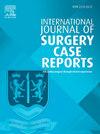A pipkin type IV injury treated with acetabular reconstruction and primary total hip replacement surgery: A case report
IF 0.6
Q4 SURGERY
引用次数: 0
Abstract
Introduction and importance
Acetabular fractures are uncommon and serious injuries to the hip joint occurring in 3 out of 100,000 individuals annually, commonly affects young people. In young individuals usually occurs from high-energy trauma and usually accompanied with associated injuries.
Case presentation
54 years old male involved in a motor traffic crash as a driver who had head-to-head collision with a tractor and sustained right hip injury and loss of consciousness for an unknown period of time. On admission pelvis X-ray and CT scan were done, he was diagnosed with 1. mild traumatic brain injury, 2. posterior hip dislocation with comminuted posterior wall acetabular fracture, and 3. femoral head fracture pipkin IV. E-fast was negative, chest X-ray revealed cardiomegaly, echocardiogram and electrocardiogram were unremarkable. He was kept on right distal femur skeletal traction temporarily, definitively acetabular reconstruction and total hip replacement were done.
Discussion
Posterior wall acetabular fracture with posterior column fracture if treated with ORIF results into failed fixation in 31.8 %, osteoarthritis in 63.6 %. 46 % of patients above 50 yrs treated with ORIF will end up requiring a late total hip replacement. Early treatment with total hip replacement results into better outcome compared to total hip done secondary to posttraumatic arthritis and failed fixation.
Conclusion
Primary total hip replacement is a best treatment modality in patients with severely comminuted posterior wall acetabular fracture due to the fact that open reduction and internal fixation is associated with more complications and inferior outcome compared to early total hip replacement.
髋臼重建术和全髋关节置换术治疗pipkin IV型损伤1例
髋臼骨折是一种罕见的髋关节严重损伤,每年每10万人中发生3例,通常影响年轻人。在年轻个体中通常发生于高能创伤,通常伴有相关损伤。病例介绍54岁男性,在一起机动车交通事故中与一辆拖拉机迎头相撞,右髋关节受伤,意识丧失,持续时间不详。入院时骨盆x线及CT检查,诊断为1。轻度创伤性脑损伤,2。髋关节后脱位伴髋臼后壁粉碎性骨折;pipkin IV. E-fast阴性,胸片示心脏肿大,超声心动图、心电图无明显变化。患者暂时保持右股骨远端骨牵引,最终行髋臼重建和全髋关节置换术。髋臼后壁骨折合并后柱骨折经ORIF治疗后固定失败率为31.8%,骨关节炎发生率为63.6%。在接受ORIF治疗的50岁以上的患者中,46%最终需要晚期全髋关节置换术。与继发于创伤后关节炎和固定失败的全髋关节置换术相比,早期全髋关节置换术的治疗效果更好。结论与早期全髋关节置换术相比,首次全髋关节置换术并发症多,预后差,是治疗髋臼后壁严重粉碎性骨折的最佳方法。
本文章由计算机程序翻译,如有差异,请以英文原文为准。
求助全文
约1分钟内获得全文
求助全文
来源期刊
CiteScore
1.10
自引率
0.00%
发文量
1116
审稿时长
46 days

 求助内容:
求助内容: 应助结果提醒方式:
应助结果提醒方式:


